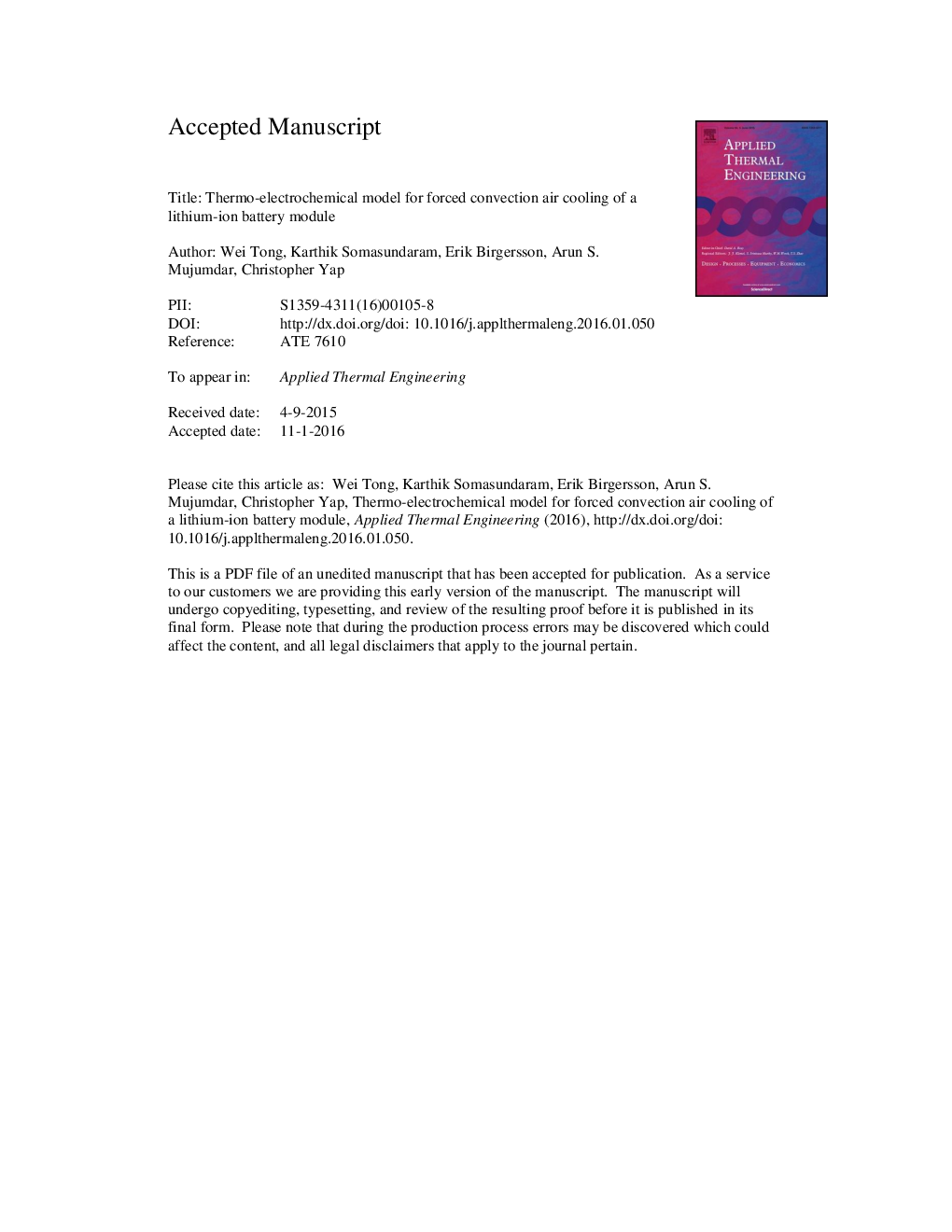| کد مقاله | کد نشریه | سال انتشار | مقاله انگلیسی | نسخه تمام متن |
|---|---|---|---|---|
| 644722 | 1457129 | 2016 | 25 صفحه PDF | دانلود رایگان |
عنوان انگلیسی مقاله ISI
Thermo-electrochemical model for forced convection air cooling of a lithium-ion battery module
ترجمه فارسی عنوان
مدل ترمو-الکتروشیمیایی برای خنک سازی هوای خنک کنونی یک ماژول باتری لیتیوم یون
دانلود مقاله + سفارش ترجمه
دانلود مقاله ISI انگلیسی
رایگان برای ایرانیان
کلمات کلیدی
خنک کننده هوا، ماژول باتری لیتیوم یون، مدل سازی، مدیریت حرارتی، جریان معکوس،
ترجمه چکیده
مدیریت حرارتی برای عملکرد ایمن و قابل اطمینان سیستم های باتری لیتیوم یونی حیاتی است. در این مطالعه، یک مدل حرارتی الکتروشیمیایی یونی لیتیوم یون با تعامل با مدل دو بعدی حرارتی سیلیکونی برای خنک سازی اجباری اجاق گاز با یک ماژول باتری لیتیوم یونی ارائه شده و به صورت عددی حل شده است. این رویکرد متصل، مدل را منحصر به فرد تر و دقیق تر می سازد، زیرا حمل و نقل داخل هر سلول در ماژول باتری حل شده است و به همین ترتیب مقیاس های طول و طول زمانی را پوشش می دهد. اثر پارامترهای طراحی و پارامترهای عملکرد سیستم مدیریت حرارتی بر عملکرد ماژول باتری با استفاده از مدل ترکیبی ارزیابی می شود. یافته شده است که افزایش دما پایین تر از ماژول باتری می تواند با افزایش سرعت ورودی هوا یا کاهش فاصله بین سلول ها به دست آید. افزایش سرعت ورودی هوا، تنظیم سلول تقسیم شده و یا جریان برگشت پذیر دوره ای فرکانس برگشت پذیر باعث توزیع درجه حرارت یکنواخت در ماژول می شود. با این حال، انجام این کار باعث افزایش بار انگلی و همچنین حجم ماژول باتری می شود که از این رو باید میان این پارامترها در نظر گرفته شود.
موضوعات مرتبط
مهندسی و علوم پایه
مهندسی شیمی
جریان سیال و فرایندهای انتقال
چکیده انگلیسی
Thermal management is critical for safe and reliable operation of lithium-ion battery systems. In this study, a one-dimensional thermal-electrochemical model of lithium-ion battery interactively coupled with a two-dimensional thermal-fluid conjugate model for forced convection air cooling of a lithium-ion battery module is presented and solved numerically. This coupled approach makes the model more unique and detailed as transport inside each cell in the battery module is solved for and thus covering multiple length and time scales. The effect of certain design and operating parameters of the thermal management system on the performance of the battery module is assessed using the coupled model. It is found that a lower temperature increase of the battery module can be achieved by either increasing the inlet air velocity or decreasing the distance between the cells. Higher air inlet velocity, staggered cell arrangement or a periodic reversal airflow of high reversal frequency results in a more uniform temperature distribution in the module. However, doing so increases the parasitic load as well as the volume of the battery module whence a trade-off should be taken into account between these parameters.
ناشر
Database: Elsevier - ScienceDirect (ساینس دایرکت)
Journal: Applied Thermal Engineering - Volume 99, 25 April 2016, Pages 672-682
Journal: Applied Thermal Engineering - Volume 99, 25 April 2016, Pages 672-682
نویسندگان
Wei Tong, Karthik Somasundaram, Erik Birgersson, Arun S. Mujumdar, Christopher Yap,
